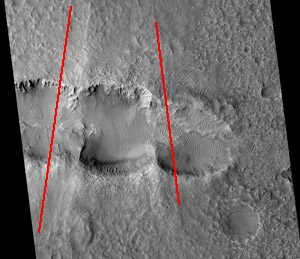What the heck hit Mars and made this?
[Click to barsoomenate.]
This image is from my favorite Red Planet paparazzo, the HiRISE camera on Mars Reconnaissance Orbiter. It shows three craters, each about 1.5 to 2 km (0.9 to 1.2 miles) across… and they all formed at the same time!
How can I tell? Well, for one thing, if this were a coincidence, with three impacts happening at very different times, then you’d see overlap in the crater rims; the earliest crater would be partially obscured by the later crater, and that in turn by the most recent impact. But that’s not the case here, since the rims aren’t overlaying each other. In fact, the straight walls between them are exactly what you’d expect if you have impact explosions happening simultaneously: the expanding shock waves smack into each other and create a linear feature.
 Not only that, but let your eye follow the straight lines between craters up and down, above and below the craters themselves and onto the landscape. You can see that the hellish expanding wall of fire etched itself onto the Martian surface well beyond just the crater rims, and those linear features match the crater wall orientation. I annotated the image here to show you what I mean; the red lines are just outside the linear features.
Not only that, but let your eye follow the straight lines between craters up and down, above and below the craters themselves and onto the landscape. You can see that the hellish expanding wall of fire etched itself onto the Martian surface well beyond just the crater rims, and those linear features match the crater wall orientation. I annotated the image here to show you what I mean; the red lines are just outside the linear features.
I can picture what must have happened, millions of years ago over Mars… An asteroid or perhaps a comet is orbiting the Sun, minding its own business. Most likely it’s a frail body, easily broken apart, but held together by its own gravity. As long as it’s left undisturbed, that is. And what’s that looming ahead? A small planet, but too large to avoid. It grows larger, and larger still… As the object plunges into the thin air of Mars, it breaks up into three similar sized pieces, each perhaps a hundred meters or so across, the size of a football stadium. Moving at the blinding speed of 30 kilometers per second, each of the three pieces hit. Given the crater centers are only about 2 kilometers apart, all three pieces impacted the surface within a fraction of a second of each other.
At essentially the same moment, three fireballs are created, explosions equivalent to the detonations of tens of millions of tons of TNT. Each creates a circular shock wave expanding along the ground, and within a few seconds the shock waves collide. On either side of the center impact, two focused walls of flame and debris are created, blasting up and down in nearly straight lines. The explosions of the two outer impacts expand left and right in near perfect half-circles.
Later, much later, when the area cooled off, what remained is what we see today. Three conjoined craters, the magnitude and fury of their impacts faded by time, but still readable in the landscape. They’re filled with rippling sand dunes now, grains of rust and basalt blown by the ever-present Martian winds. But they’re a reminder of a time, long ago, when, for a few moments, the wind blew much, much harder.
Image credit: NASA/JPL/University of Arizona
Related posts:
- Another awesome Martian avalanche
- Martian dunes under the microscope
- WHAM! Bulls-eye!
- Landslide on Mars triggered by an impact?